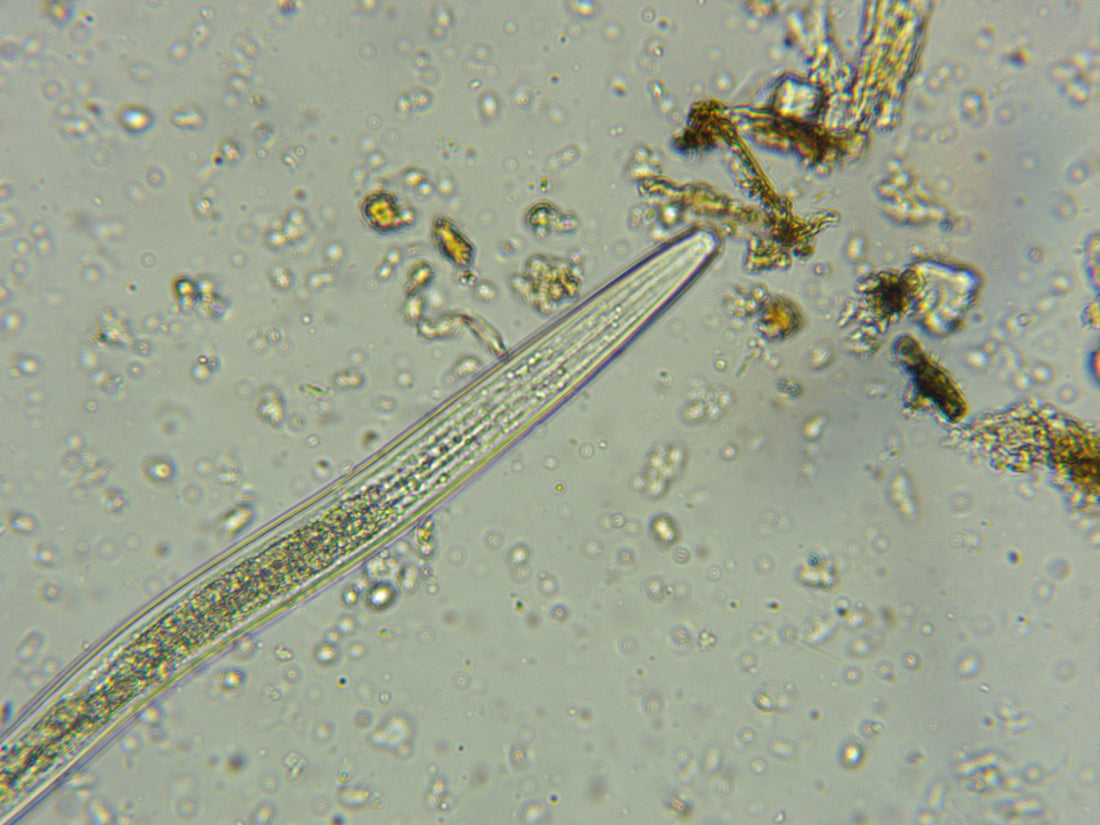Come, meet your soil!
There's been increasing attention on the importance of soil in helping to heal our planet, and phrases like "living soil," "nutrient cycling," "carbon sequestration," and "soil water retention" are frequently used to describe how it can do that. But what do those terms mean? How does this all work?
I've been learning about these concepts as a student at the Soil Food Web School for a year now. I've completed the Foundation Courses and am now studying to be a Certified Lab Technician who can conduct soil biology assessments using a microscope to identify the level of biological diversity in soil and determine what stage of succession it is in. The results of a biological soil assessment informs decisions about what remedial actions to take to build the soil you need to best cultivate the plants you want to grow.

What makes living soil alive? What does carbon sequestration look like? How does healthy soil retain water? I took some photos with my microscope to begin to illustrate some of these foundational ideas. This is by no means an exhaustive summary of what's happening in the soil; it's just a brief look at some of the key processes.
Dirt
Let's start with what dirt looks like. Dirt is not soil. Dirt is mineral material (sand, silt, clay) with little to no organic material, a non-diverse set of bacteria, and it has no structure.

Dirt
Living soil, on the other hand, has the entire soil food web present, a sufficient amount of organic material, and soil structure. The soil food web includes a diverse set of bacteria and fungi that digest minerals and organic matter, plus predators that eat the bacteria and fungi. The microbial predators include protozoa, nematodes, and microarthropods.
Bacteria and Fungi
Bacteria and fungi break down minerals and organic material by producing enzymes that pull specific nutrients loose and then consuming those nutrients.
This is an example of a fungal hypha with its slightly rounded growing tip as it reaches through the soil for nutrients. The two pieces of dark material are clumps of organic material, and their color is that of fulvic and humic acids, byproducts of fungal life in the soil. Bacteria are everywhere in all of these pictures. If a tiny dot or rod has smooth sides, then it is probably a bacterium.

Growing tip of a fungal hypha
Microbial predators
The nutrients that the bacteria and fungi are consuming from minerals and organic matter become part of those organisms. Soil predators are necessary to complete the process of making the nutrients available to plants. Predators eat the bacteria and fungi and expel excess nutrients as waste in an organic form that plants can take up.
You will find two different types of protozoa in healthy soil - amoeba and flagellates. (We'll talk about unhealthy soil protozoa in another blog.)
This is a testate amoeba. The clear oval is her protective shell and she is peeking out to eat bacteria, which you can see inside her clear body.

Testate Amoeba
This is another type of amoeba called Arcella. You can see nutrient cycling in action in this picture. The vacuoles (the things that look like air pockets) fill with the protozoan's waste and the amoeba will periodically empty its contents into the soil, releasing nutrients in plant available organic forms.

Arcella (amoeboa)
Flagellates bumble around the soil eating bacteria and cycling nutrients like the amoeba.

Flagellate credit: https://www.digopaul.com/english-word/flagellate.html
Nematodes are tiny worms in the soil that specialize in eating either bacteria, fungi, roots (these are the bad nematodes that can harm your plants), or other nematodes. Here's a nematode that eats fungi.

Fungal Feeding Nematode
Microarthropods can eat any of these organisms and further contribute to cycling nutrients.

Microarthropod

Tardigrade, or Water Bear
Carbon sequestration by fungi
Carbon sequestration means storing carbon in biological or geological forms instead of in the atmosphere where it contributes to climate change. There's a lot to it, but I wanted to give one clear example of how a healthy soil food web can contribute to it removing carbon from our air.
As fungi grow, they layer most of the carbon they consume along their walls, storing it indefinitely in the soil. (This process begins with photosynthesizing plants capturing carbon from the atmosphere, a topic we'll discuss in another blog.) You can see this effect in this photo of a fungal hypha.

Fungal hypha wall
Soil structure and water retention
In addition to nutrient cycling and carbon sequestering, these organisms are also building soil structure. Bacteria produce glues to help them stick to their food sources, which causes clumps of material to form. Fungi then form around these clumps, holding them together into even larger clumps.

Soil Aggregate
These structures improve the soil in several ways. The spaces they create become hiding places or feeding grounds for the soil food web organisms. The passageways provide roots paths so they can more easily grow into the soil. And, these spaces facilitate the absorption of water into the soil (instead of it running off the top taking nutrients with it), and the pockets are able to store water in place, holding it closer to the plant for longer periods of time.
Conclusion
There are countless different types of microbial life in healthy soil and these images are just a small sample to help you begin to visualize the critically important microscopic world beneath our feet.
Photo credits: by Robbin Pott unless otherwise noted.


